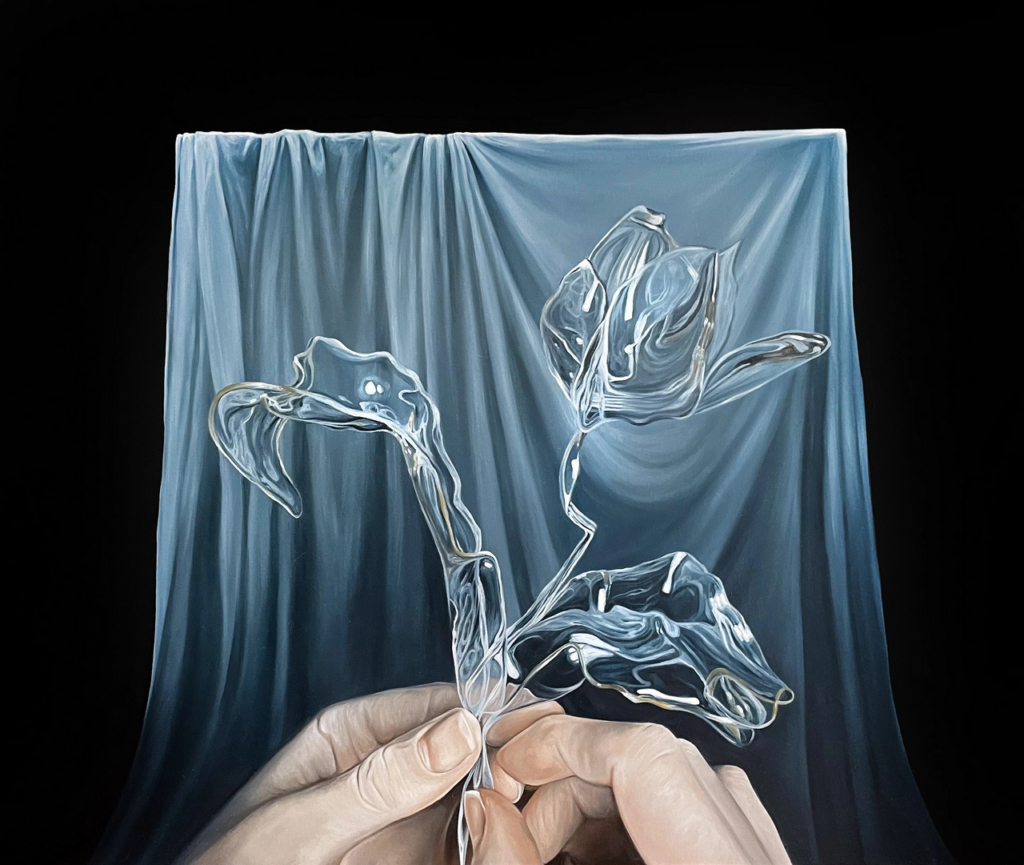Inside a bright room the somber colors of the oil paintings are presented in an atmosphere of contemplation. Emily Pope’s solo exhibition, Antidote for Yearning, presents a poignant exploration of human beings’ innate tendency to attach themselves to fleeting moments, despite knowing that time will inevitably render them impermanent.
Through a collection of evocative paintings at Abbozzo Gallery, Pope’s work challenges traditional female representation, exploring the tension between societal expectations and personal identity. Pope, a Toronto-based painter, weaves together figurative elements, symbolic objects like curtains, glass flowers, bubbles, pearl beads, and still life to explore the complexities of womanhood and themes of longing, identity, and transformation. Her work offers personal antidotes to the passage of time, revealing the fragility and beauty of all attempts to hold onto what is momentary.
A distinctive visual language emerges, characterized by the recurring symbolism of curtains, stages, and floors. The curtain, in particular, serves as a leitmotif, appearing in various forms throughout the exhibition. This deliberate use of symbolic imagery invites the viewer to consider the ways in which human lives are shaped by the interplay between reality and performance. “A Lesson in Flying” depicts a ballerina’s feet, firmly grounded on a checkerboard patterned floor, which serves as a metaphor for the tension between structure and freedom. The ballerina’s feet, adorned with delicate ribbons and light blue feathers, appear poised between movement and stillness, reflecting the human experience of navigating desire and constraint. The dark blue curtain in the background highlights the contrast between the external world and the individual’s inner experience.
Emily Pope, A Lesson in Flying, 2024, oil on canvas, 24 x 30 in
Nearby, “Curtain Call” captures the final moment of a performance, as a gloved hand, embellished with bows and pearls, emerges as the curtain falls, relinquishing its grasp on the spotlight. Neither the torn gloves nor all the bows and pearls matter anymore. This moment of transition and transformation speaks to Pope’s exploration of the emotional landscapes of identity, longing, and the human experience.
Emily Pope, Curtain Call, 2024, oil on canvas, 32 x 34 in
“Keeper of Nothing” and “First Word: Memento Mori” are two more thought-provoking pieces in the exhibition that offer insight into the artist’s personal reflections. For Pope, “Keeper of Nothing” was a long-held contemplation of what she could hold onto through her body of work. A glass dome, typically used to safeguard delicate objects, here holds nothing, prompting the viewer to consider the human longing for preservation and the inevitability of impermanence. The concept of “First word: Memento Mori” is deeply personal for Pope, evoking memories of her childhood and the inevitability of mortality. Knowing from her mother that ‘bubble’ was the first word she spoke became a memento. She put that idea into “Memento Mori” as a symbol that the artist holds her first word “bubble” in her fingers, reminding her of time she can’t get back. While the phrase “Memento Mori” is the recognition of death; the bubble, transparent nails, and the glass dome perfectly depict the longing for something that will never stay.
Emily Pope, Keeper of Nothing, 2024, oil on canvas, 28 x 20 in (above) and First Word: Memento Mori, 2024, oil on canvas, 14 x 18 in (below)
The center piece of Pope’s theme “I’ve Begged for Less” depicts a glass flower portraying a person’s illusion that life will remain as it is. In the dark, the curtain is a symbol of someone’s blindness from reality, wanting to freeze time and preserve life, in a delusional world.
Emily Pope, I’ve Begged for Less, 2024, oil on canvas, 32 x 38 in
Pope highlights the futility of avoiding death by drawing the audience into the present. “Refusal to Rot” is a poignant painting that depicts a real flower pierced by a pin, its stem serving as a sharp reminder of how vulnerable life is. The floral element, which represents the passage from past to present, serves as a potent symbol of mortality, underscoring the inevitability of decay. In contrast, “Crying over Peeled Grapes” presents a paradoxical scene, where a delicate, bubble-like bunch of grapes is held alongside a broken wine glass on a table. Hopefully these glass bubble-like grapes will never be crushed to become wine and can remain as they are to prove that life is full of beauty and wonder.
Emily Pope Canadian, A Refusal to Rot, 2024, oil on canvas, 26 x 22 in (left) and Crying Over Peeled Grapes, 2024, oil on canvas, 28 x 24 in (right)
Using symbolism and still life, Emily Pope masterfully conveys the complexities of human emotions, inviting viewers to reflect on their own desires and identities, and how their relationships with reality are marked by longing, impermanence and the quest for meaning. Ultimately, Pope’s paintings serve as antidotes, providing a remedy through the process of thinking and spending time with these works, and how they encourage self-reliance and acceptance, as we navigate the intangible experiences of existence.
Nusrat Papia
Images are courtesy of Abbozzo Gallery
*Exhibition information: Emily Pope, Antidote for Yearning, November 8 – December 7, 2024, Abbozzo Gallery, 401 Richmond Street West, Suite 128, Toronto. Gallery hours: Tue – Fri 11am – 6pm, Sat 11am – 5pm.






